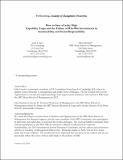| dc.contributor.author | Lyneis, John Landry | |
| dc.contributor.author | Sterman, John | |
| dc.date.accessioned | 2019-03-26T12:38:33Z | |
| dc.date.available | 2019-03-26T12:38:33Z | |
| dc.date.issued | 2016-03 | |
| dc.identifier.issn | 2168-1007 | |
| dc.identifier.uri | http://hdl.handle.net/1721.1/121086 | |
| dc.description.abstract | Can managers enhance social responsibility while also improving profitability? Research demonstrates that there are “win-win” investments that improve both socially desirable outcomes and the bottom line, from energy and the environment to wages and workplace safety. Yet many such opportunities are not taken—money is left on the table. Here we explore this puzzle using the case of energy efficiency in a large research university, a setting that should favor implementation of win-win actions. However, despite a long time horizon, large endowment and pro-social mission, the university failed to implement many programs offering both large environmental and financial benefits. Using ethnographic field study and panel regression we develop a novel simulation model integrating energy use, maintenance, and facilities renewal. We find that the organization inadvertently fell into a capability trap in which poor performance prevented investments in win-win opportunities and the capabilities needed to realize them, perpetuating poor performance. Escaping the trap requires investments large enough and sustained long enough to cross tipping thresholds that convert the vicious cycle in to a virtuous cycle of better performance, greater investment and still better performance. We discuss how the organization is escaping from the trap and whether the results generalize to other contexts. | en_US |
| dc.publisher | Academy of Management | en_US |
| dc.relation.isversionof | http://dx.doi.org/10.5465/AMD.2015.0006 | en_US |
| dc.rights | Creative Commons Attribution-Noncommercial-Share Alike | en_US |
| dc.rights.uri | http://creativecommons.org/licenses/by-nc-sa/4.0/ | en_US |
| dc.source | MIT web domain | en_US |
| dc.title | How to Save a Leaky Ship: Capability Traps and the Failure of Win-Win Investments in Sustainability and Social Responsibility | en_US |
| dc.type | Article | en_US |
| dc.identifier.citation | Lyneis, John, and John Sterman. “How to Save a Leaky Ship: Capability Traps and the Failure of Win-Win Investments in Sustainability and Social Responsibility.” Academy of Management Discoveries 2, no. 1 (March 2016): 7–32. | en_US |
| dc.contributor.department | Massachusetts Institute of Technology. Institute for Data, Systems, and Society | en_US |
| dc.contributor.department | Sloan School of Management | en_US |
| dc.contributor.mitauthor | Lyneis, John Landry | |
| dc.contributor.mitauthor | Sterman, John | |
| dc.relation.journal | Academy of Management Discoveries | en_US |
| dc.eprint.version | Author's final manuscript | en_US |
| dc.type.uri | http://purl.org/eprint/type/JournalArticle | en_US |
| eprint.status | http://purl.org/eprint/status/PeerReviewed | en_US |
| dc.date.updated | 2019-02-28T17:52:57Z | |
| dspace.orderedauthors | Lyneis, John; Sterman, John | en_US |
| dspace.embargo.terms | N | en_US |
| dc.identifier.orcid | https://orcid.org/0000-0001-7476-6760 | |
| mit.license | OPEN_ACCESS_POLICY | en_US |
